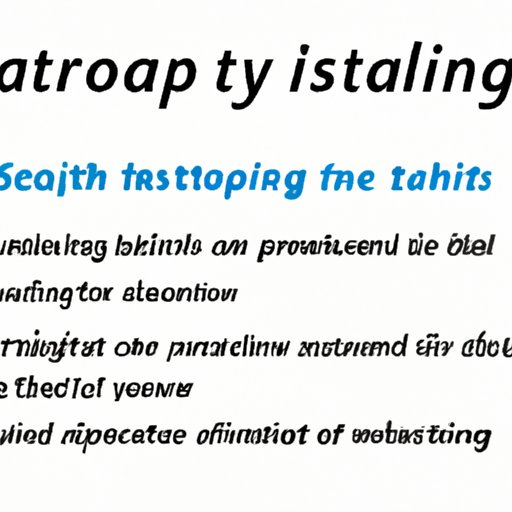
Introduction
First impressions matter, and the opening paragraph of your article is no exception. It is the first point of contact with your reader and can make or break their interest in continuing reading the rest of your work. Therefore, starting with a strong introduction is key to captivate your audience. In this article, we will explore different techniques that you can use to start an introduction paragraph and engage your readers.
Begin with a Compelling Statement or Question
A compelling statement or question is a statement or question that hooks the reader’s attention right from the start. It should be thought-provoking, intriguing, or controversial, making your reader want to continue reading to find out more. This technique is especially effective for opinion articles, blogs, or feature stories.
For example, instead of saying, “This article is about the benefits of yoga,” you could start with a compelling statement such as “Did you know that practicing yoga for just ten minutes a day can reduce stress, improve flexibility, and strengthen your immune system?”
Provide Some Background Information
Another effective way to start an introduction paragraph is by providing some background information. This technique helps to establish context, provide historical information and set the tone for your piece. It is well suited for informative or educational articles such as essays, reports, or reviews.
For instance, if you are writing an article about the history of jazz, you could start by providing some context, such as “Jazz music has played a crucial role in the American music scene for over a century.” You could then provide a brief overview of its evolution or key figures before jumping into your main argument.
Use a Quote
Incorporating a quote in your introduction can add credibility, establish an authoritative tone, and make your article more memorable. Quotes can come from famous people or experts in your field and should be relevant to the topic you are exploring. This technique works well for editorial, opinion, or feature articles.
For example, if you are writing about innovation, you could start with a quote from Steve Jobs, “Innovation distinguishes between a leader and a follower,” to introduce your topic and set the tone for your article.
Offer a Surprising or Incongruous Fact or Statistic
A surprising or incongruous fact or statistic can be an excellent way to catch your reader’s attention and start your article on a high note. This technique works well for persuasive, argumentative, or informative articles.
For instance, if you are writing an article about the benefits of drinking coffee, you could start with a surprising fact such as “Did you know that drinking coffee can improve your memory and help you live longer?” This unexpected statement is likely to pique the reader’s interest and make them want to learn more.
Start with a Personal Anecdote
Personal anecdotes can create an emotional connection with your reader and make your article more relatable. They work well for opinion, narrative, or feature articles that require a more personal touch.
For example, if you are writing an article about traveling, you could start with a personal anecdote such as “The first time I traveled to Japan, I was struck by the stark contrast between the bustling cityscape of Tokyo and the peaceful serenity of the countryside.” This anecdote provides a glimpse into your personal experience and invites the reader to continue reading.
Pose a Series of Rhetorical Questions
Rhetorical questions are questions that do not require a response but are used to make a point or invite the reader to consider a specific idea or concept. This technique can help create engagement and build suspense, making it ideal for academic, persuasive, or informational articles.
For instance, you could start an article on climate change by posing a series of rhetorical questions such as “What will happen to our planet if we continue to ignore the warning signs? Can we afford to delay action any further? What role can we play in combating climate change?” These questions engage the reader on a deeper level and build up to your thesis statement or main argument.
Use Humor (if Appropriate)
Humor can be a fantastic way to engage your reader and set a light-hearted tone for your article. However, it’s important to remember that not all topics are suitable for humor, and what one person finds funny may not appeal to another. It’s essential to balance humor with the seriousness of your topic.
For example, you could start an article about cooking with a pun such as “Lettuce turnip the beet and spice things up in the kitchen.” This playful tone sets the stage for a fun and light-hearted article about cooking.
Conclusion
Starting an introduction paragraph can be challenging, but with these techniques, you are sure to capture your reader’s attention from the start. Whether you choose to begin with a compelling statement, provide some background information, use a quote, offer a surprising fact or use any of the techniques we have presented here, ensure that it aligns with your intended tone and purpose.
It’s also important to experiment and find the approach that works best for your writing style and topic. With practice, you can become proficient at captivating your reader’s attention, setting the tone for your article and inspiring them to read on.




